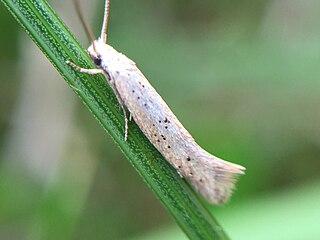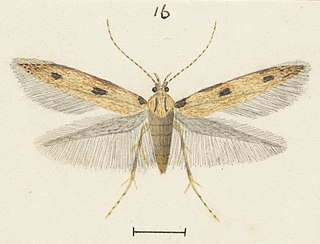Related Research Articles

Elachista gerasmia is a species of moth of the family Elachistidae that is found in New Zealand and south eastern Australia.
”Elachista” arctodyta is a moth of the family Scythrididae. It is found in Australia, including Western Australia.

Pseliastis is genus of moths in the family Heliozelidae, first described by Edward Meyrick in 1897. Three species are currently described, all endemic to Australia.
Pseliastis spectropa is a species of moth of the family Heliozelidae, described by Edward Meyrick in 1897. It is endemic to Tasmania, Australia.
Pseliastis trizona is a species of moth in the family Heliozelidae, described by Edward Meyrick in 1897. It is endemic to Tasmania, Australia.

Pseliastis xanthodisca is a species of moth in the family Heliozelidae, described by Edward Meyrick in 1897. It is endemic to Tasmania, Australia.

Labdia anarithma is a moth of the family Cosmopterigidae. It was described by Edward Meyrick in 1888. It is found in New Zealand and throughout Australia. Adults are on the wing from December to March and are day flying. They have been collected by sweeping bracken fern.
Ascalenia exodroma is a moth in the family Cosmopterigidae. It was described by Edward Meyrick in 1897. It is found in Australia, where it has been recorded from Queensland.
Ascalenia semnostola is a moth in the family Cosmopterigidae. It was described by Edward Meyrick in 1897. It was described from the Australian state of New South Wales, but has also been recorded from South Africa.

Elachista ochroleuca is a moth in the family Elachistidae. It was described by Edward Meyrick in 1923. It is endemic to New Zealand and has been observed in the South Island. The adults of this species are day flying and are on the wing from October until March.

Elachista archaeonoma is a species of moth in the family Elachistidae. It was first described by Edward Meyrick in 1889. It is endemic to New Zealand.
"Elachista" argopis is a moth in the family Cosmopterigidae. It was described by Edward Meyrick in 1897. It is found in Australia, where it has been recorded from Western Australia.
"Elachista" cataptila is a moth with an unclear taxonomic position. It was described by Edward Meyrick in 1897. It is found in Australia, where it has been recorded from Western Australia.

Elachista thallophora is a moth in the family Elachistidae. It was described by Edward Meyrick in 1888. It is found in New Zealand.

Coracistis is a monotypic moth genus in the family Elachistidae. Its only species, Coracistis erythrocosma, is found in Australia, where it has been recorded from Victoria. Both the genus and species were first described by Edward Meyrick in 1897. It

Microcolona limodes is a species of moth in the family Elachistidae. It is endemic to New Zealand. The larvae of this moth eat the seeds of endemic Myrsine species.
Microcolona ponophora is a moth in the family Elachistidae. It was described by Edward Meyrick in 1897. It is found in Australia, where it has been recorded from New South Wales.
Microcolona sollennis is a moth in the family Elachistidae. It was described by Edward Meyrick in 1897. It is found in Australia, where it has been recorded from New South Wales.
Microcolona thymopis is a moth in the family Elachistidae. It was described by Edward Meyrick in 1897. It is found in Australia, where it has been recorded from New South Wales.
Microcolona trigonospila is a moth in the family Elachistidae. It was described by Edward Meyrick in 1897. It is found in Australia, where it has been recorded from New South Wales and Victoria.
References
- ↑ Beccaloni, G.; Scoble, M.; Kitching, I.; Simonsen, T.; Robinson, G.; Pitkin, B.; Hine, A.; Lyal, C., eds. (2003). "Elachistidae unplaced species demogenes". The Global Lepidoptera Names Index . Natural History Museum . Retrieved May 22, 2018.
- ↑ Markku Savela, ed. (9 May 2023). "Elachista". Lepidoptera and some other life forms. Retrieved 2023-07-15.
- ↑ Meyrick, Edward (1897). "Descriptions of Australian Micro-Lepidoptera". Proceedings of the Linnean Society of New South Wales. 22 (2). Sydney: Linnean Society of New South Wales: 397–435.
 This article incorporates text from this source, which is in the public domain .
This article incorporates text from this source, which is in the public domain . - ↑ Kaila, Lauri (2011-06-07). Elachistine Moths of Australia: (Lepidoptera: Gelechioidea: Elachistidae). Csiro Publishing. ISBN 978-0-643-10305-4.